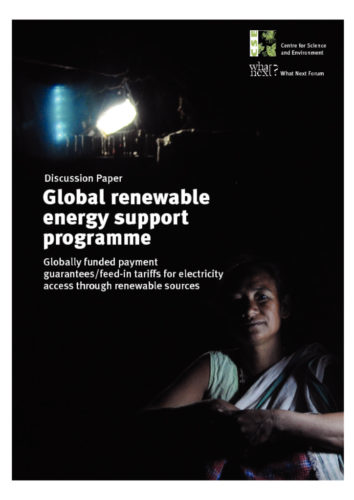PUBLICATION

Global Renewable Energy Support Programme
A discussion paper on Globally funded payment guarantees/feed-in tariffs for electricity access through renewable sources produced by WhatNext? and Centre for Science and Environment in the lead-up to COP14 in Lima, Peru 2014.Highlights
- The Global Renewable Energy Support Programme is a bold initiative that emphasises well being, sufficiency and genuine development by simultaneously addressing energy access, climate change and collaboration between North and South
- The Green Climate Fund should help finance the transition to a renewable energy future in all developing countries.
- The goal is to provide sufficient and clean energy for round-the-clock supply and not just bare minimum lighting.
- A 100 per cent renewable energy future is possible and necessary to avoid climate catastrophe.
- Renewable energy is available everywhere. Therefore, the idea of decentralised distributed generation where people live makes full sense.
- Mini-grids – both isolated and connected to the national grid – are quickly being recognised as a key part of the equation.
- Communities have a large role to play in the future energy models, creating a web of electricity producers and consumers.
- More than 100 countries across the globe have adopted payment guarantees/ feed-in tariff mechanisms to encourage renewable energy.
- With time, costs of generating power from renewable energy sources decline and the costs of power generated from fossil fuels increase. Renewable energy becomes the default, affordable choice.
- Payment guarantees and feed-in tariffs are result-based and spread over the whole or large part of the lifetime of a renewable installation.
- Payment guarantees/ feed-in tariffs are the most effective and efficient policy tools we can rely on.
- Developed countries must, in addition to the most radical emissions reductions conceivable at home, make possible for the developing countries to forgo fossil fuels.
- More wealthy developing nations would be entitled to considerable financial support, but would need to fund part of reductions on their own.
- Genuine investments early on will help bend the curve and avoid much costlier actions later, thereby freeing up climate finance for adaptation.
- After 20-40 years, there may no longer be a requirement of payment guarantees for renewable energy.
- Implementation of the support mechanism can be achieved through meagre methods, largely building on existing institutions.
- National strategies and assessments should involve social movements, civil society, academics, and industry along with the relevant government agencies.
- Financing of decentralised, community- oriented renewable energy fits the main criteria of the Green Climate Fund perfectly.
- Developing countries can now approach GCF with proposals to fund national systems for supporting renewable energy-based mini-grids.
- Structures and rules must be set up with a particular emphasis on local and community- based entities within both the public and private sectors.
- Forerunning countries in both North and South can take a lead by concrete, joint formulation of principles and working models.
More info/Summary
The world needs bold, transformative solutions that can bend the present trajectories of sustained, and even worsening, energy inequalities while simultaneously addressing the escalating threats of climate change. We need real political leadership that can implement grand solutions, but in ways that allow and stimulate real people on the ground to build locally appropriate solutions for power generation from below. We need a different mode of conversation than the distrustful and non-imaginary impasse we are currently locked in, and that colours climate negotiations and much of international debates. And we need different development models that emphasise well- being, sufficiency and creativity.
This discussion paper on a Global Renewable Energy Support Programme presents one such approach. It is not the single answer – a silver-bullet – to all our problems, but it could, if implemented well, have a considerable impact at several different levels.
It could provide a roadmap for access to affordable, clean electricity to all the 1.3 billion people currently lacking any access and the more than double who have a bare minimum. It could help promote a new, modern, decentralised energy model where people everywhere – in rural and urban centres – become more closely connected to energy production, and societies everywhere rid themselves of dependence on large, centralised and dirty fossil fuels.
It could help societies in both North and South to effectively tackle climate change by accelerating the transition to renewable energy. Countries in the global North can get inspired and challenge themselves to redirect their current energy systems (and lessen consumption). Countries in the global South, supported by countries in the global North, can immediately embark on ambitious trajectories towards 100 per cent renewable community-oriented energy, thereby avoiding massive amounts of future emissions.
It could help rebuild trust between North and South, by providing an example of a truly collaborative scheme with countries of the South in the driving seat. If initiated successfully, it could spur interest in similar bold, visionary public investment approaches in other sectors.
Much is already happening. Several countries, including the Africa Group,1 are promoting this idea within the United Nations Framework Convention on Climate Change (UNFCCC)space. Civil society is increasingly getting interested and is beginning to see this idea as one of the major outcomes of COP21 in Paris a year from now.
Having promoted this idea for several years, it is encouraging to note the interest that is building up, and to help foster the continued elaboration of, and support for, the idea.
This discussion paper seeks to provide an overview of the various components of the detailed design options to serve as a basis for further discussions. It also seeks to generate further political support so that real action and implementation can take place in the months and years to follow.
The paper follows a logic of first outlining the needs and visions, thereafter presenting the modern, decentralised, renewable energy model, highlighting the importance of payment guarantees and feed-in tariffs as key policy tools, and, in the second part, elaborating how international public financing is essential and can be set up to support all developing countries’ quest for renewable energy and universal access to electricity. The paper ends with discussions on risks and safeguards, and concrete next steps.
The paper makes an argument at two levels simultaneously. At an overarching level it makes the case for the creation of global partnerships and the need and obligation of rich countries, with the Green Climate Fund as one central component, to finance the leveraging that is needed to enable a renewable energy transition in developing countries. At a more detailed level, it makes a strong case for so called “payment guarantees” and “feed-in tariff” systems to constitute the key policy tools that could drive much of such a transition. “Globally funded feed-in tariffs” or “G-FITS” therefore easily becomes shorthand for what we are presenting, but are clearly a subset of a larger approach.

